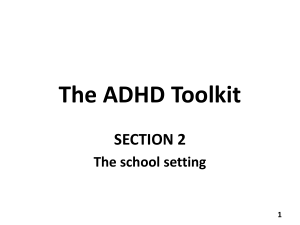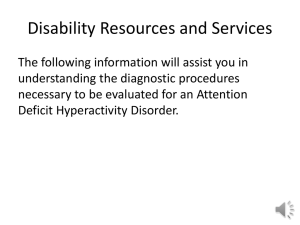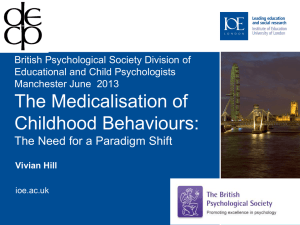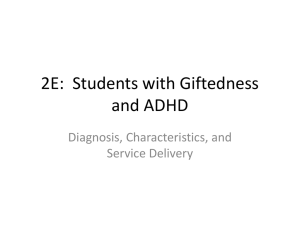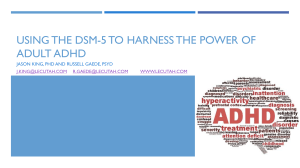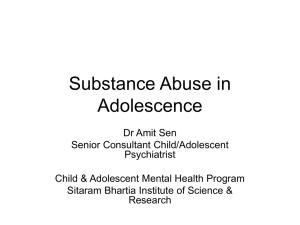Working Memory in Patients with ADHD
advertisement
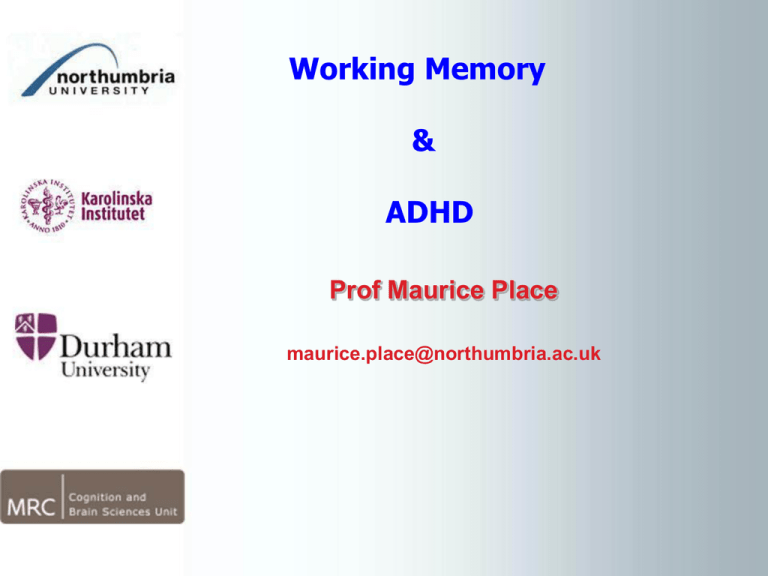
Working Memory & ADHD Prof Maurice Place maurice.place@northumbria.ac.uk Disclosure: Currently member of the speakers panel of AstraZeneca Eli Lilly Janssen Cilag Shire The executive function comprises those mental functions involved in formulating goals, planning how to achieve them, carrying out the plans, and revising those plans in the event of failure (Lezak, 1982) The executive function comprises those mental functions involved in formulating goals, planning how to achieve them, carrying out the plans, and revising those plans in the event of failure Executive functioning becomes engaged for the more high level tasks Working Memory a dynamic, short-term storage of information to be actively used or manipulated and is a localised function (Alloway et al., 2006) How Memory Works Sensory inputs are held through transient functional changes in the strength of pre-existing synaptic connections The basal ganglia and pre-frontal cortex analyze sensory inputs and decide if they're worth remembering How Memory Works Sensory inputs are held through transient functional changes in the strength of pre-existing synaptic connections The basal ganglia and pre-frontal cortex analyze sensory inputs and decide if they're worth remembering If SO - create stable and permanent changes in neural connections throughout the brain by the synthesis of new protein and the growth of new connections. (Malenka &Nicoll 1999; Kandel 2000; McNab & Klingberg 2007) How Memory Works Sensory inputs are held through transient functional changes in the strength of pre-existing synaptic connections The basal ganglia and pre-frontal cortex analyze sensory inputs and decide if they're worth remembering If SO create stable and permanent changes in neural connections throughout the brain by the synthesis of new protein and the growth of new connections. Especially during sleep (Diekelman & Born 2010) Short-term memory is the term for short-term storage of information with no manipulation or organizational element Working memory is the structures and processes used for temporarily storing and manipulating information. Professionals use working memory for… ◦ ◦ ◦ ◦ ◦ Getting to work on time Meeting deadlines at work Multi-tasking and prioritizing Working effectively in pressure situations Remembering important names and phone numbers ◦ Interaction with co-workers ◦ Writing emails, memos, or summaries Rehearsal Storage (Baddeley 2000) Anatomical and imaging studies indicate Working Memory use frontal-parietal circuitry (Paulesu et al., 1993; Smith & Jonides 1998) The processes are significantly dependent upon dopamine (Goldman-Rakic 1998). Children who have been treated for PKU tend to have a deficit in prefrontal dopamine (Diamond 2007) These children have Working Memory problems even when the primary symptoms of the disorder are successfully treated (Topakas et al., 2010; Bik-Multanowski et al., 2011) Children who have been treated for PKU tend to have a deficit in prefrontal dopamine (Diamond 2007) These children have Working Memory problems even when the primary symptoms of the disorder are successfully treated (Topakas et al., 2010; Bik-Multanowski et al., 2011) Similarly patients with Fragile X show specific deficits in Working Memory (Hooper et al., 2008; Cornish et al., 2009; Baker et al., 2011) Working Memory deficiency plays a central role in schizophrenia (Lewis et al., 2005; Lewis & Gonzalez-Burgos, 2006). Memory impairment is one of the earliest and most consistent manifestations of the disease Working Memory impairment is stable over time and is independent of psychotic symptoms (Zhang & Luck 2008; Gold et al., 2010) Working Memory deficiency plays a central role in schizophrenia (Lewis et al., 2005; Lewis & Gonzalez-Burgos, 2006). Memory impairment is one of the earliest and most consistent manifestations of the disease Working Memory impairment is stable over time and is independent of psychotic symptoms (Zhang & Luck 2008; Gold et al., 2010) It probably uses GABA pathways (Timofeeva & Levin 2011) Working Memory performance is heritable (Ando et al., 2001; Chen et al., 2009) And although no genetic correlation between gray matter density and Working Memory performance, inheritance of white matter structure is likely to be one of the mechanisms of genetic transmission (Karlsgodt et al., 2010) Indicators that a working memory needs improving Frequently late to work Underestimates time required to complete a task Problems breaking a project down into manageable steps or dealing with more than one task at a time Can’t concentrate under pressure; prone to panicking Can’t remember clients’ names or numbers after meeting them or hanging up the phone Difficulty creating neat and coherent emails, memos, or summaries Working Memory assessed using simple cognitive tasks 4 aspects of memory verbal and visuo-spatial storage (simple span) verbal and visuo-spatial processing and storage (complex span) Working Memory verbal short term memory – ability to hold verbal information in memory for a short period …eg new telephone number …problems mean slow to acquire new vocabulary verbal working memory – to hold and manipulate verbal information …links to academic ability including literacy and numeracy visuo-spatial short term memory – holding visuo-spatial information ….problems with mathematics, and word problems. visuo-spatial working memory – to hold and manipulate visuo-spatial information …links to academic ability including literacy and numeracy and is predictor of poor scholastic attainment. Working Memory assessed using simple cognitive tasks: WMI of the WAIS or WISC Automated Working Memory Assessment (Alloway, 2008) Verbal STM/Verbal simple span tasks 839251 839251 DIGIT RECALL Visuo-spatial STM/ Visuo-spatial simple span tasks MAZES MEMORY Visuo-spatial STM/ Visuo-spatial simple span tasks MAZES MEMORY Visuo-spatial STM/ Visuo-spatial simple span tasks MAZES MEMORY Verbal STM/Verbal Complex span tasks chairs lay eggs false bananas have teeth false LISTENING RECALL TASK Verbal STM/Verbal Complex span tasks chairs lay eggs bananas have teeth false false eggs, teeth LISTENING RECALL TASK Visuo-spatial WM/Complex visuo-spatial tasks SPATIAL SPAN TASK Visuo-spatial WM/Complex visuo-spatial tasks SPATIAL SPAN TASK Visuo-spatial WM/Complex visuo-spatial tasks SPATIAL SPAN TASK Visuo-spatial WM/Complex visuo-spatial tasks SPATIAL SPAN TASK Visuo-spatial WM/Complex visuo-spatial tasks SPATIAL SPAN TASK Associations with Specific Disorders Specific Working Memory problems evident in various disorders: PKU Schizophrenia Specific Working Memory problems evident in various disorders: PKU Schizophrenia Depression: deficits in working memory for both visual and verbal material even in young adulthood (Castaneda et al., 2008) Deficits which appear to persist even in the remitted state (Hasselbalch et al., 2010) Specific Working Memory problems evident in various disorders: PKU Schizophrenia Depression PTSD: (Yehuda et al., 1995;Vasterling et al., 2002; Liberzon & Sripada, 2008). with structural imaging correlating with predicted deficits (Liberzon & Sripada, 2008; Woodward et al., 2009). Specific Working Memory problems evident in various disorders: PKU Schizophrenia Depression ODD: substantial deficits in information storage and verbal and spatial domains of Working Memory. - Verbal WM less damaged in ADHD (Rhodes et al 2012) In childhood abuse: emotional forms of abuse/neglect show visual memory and emotional processing deficits. sexual abuse most associated with spatial working memory deficits, Not seen in other types of abuse. physical forms of abuse/neglect most strongly linked to processing speed and emotional processing deficits. (Gould et al., 2012) Working Memory Capacity & Learning Working Memory Capacity & Learning Important for successful learning in individual classroom activities (Gathercole & Alloway, 2008) Working Memory Capacity & Learning Associated with reading and mathematics ability (Gathercole & Pickering, 2000; Geary et al., 2004) Working Memory Capacity & Learning One specific function important in reading comprehension is processing speed. (Willcutt et al. ,2001; Laasonen et al., 2009) Commonly associated with ADHD with a correlation of 0.7 between the two disorders. (Shanahan et al., 2006) Working Memory Capacity & Learning “Most of the time when I’m reading assignments In my textbooks, I’m just licking the words rather than chewing them. That’s why I have to keep going back to read it all over again.” (Brown et al., 2011) Working Memory Capacity & Learning IN ADHD can be relatively situation specific: little impairment in ability when doing tasks which hold strong personal interest or anxiety for them, though show significant impairment in most other situations. (Brown 2009; Anmarkrud & Braten 2009) Working Memory and Academic Activity Age Pre-school Working memory is crucial for... Learning the alphabet Indicators that a working memory needs exercise Unwillingness to learn Completing a puzzle independently Infant school Junior school Senior school College Understanding textual content (reading comprehension) Inability to understand what is read Mental arithmetic Problems memorizing the multiplication table Completing homework independently Can’t complete homework without parental supervision and direction Complex math problems, especially word problems Inability to grasp/break down word problems Writing essays Difficulty writing neat, coherent essays Studying for an exam Constantly procrastinates; panics the night before an exam Participation in group projects Doesn’t listen or participate during a group project Keeping focus/interest during a lecture Difficulty remaining attentive during lectures Working Memory Capacity & Learning Message from the research: low working memory = educational underachievement Working Memory & ADHD What are the Academic and Educational Characteristics of Children with ADHD? Children with ADHD show significant academic underachievement poor academic performance educational problems (Hinshaw, 1992; Fergusson & Horwood 1995; Rapport et al., 1999; Sayal 2008; Galéra et al., 2009) What are the Academic and Educational Characteristics of Children with ADHD? IQ - compared with controls score on average within the normal range (Biederman et al., 1996) BUT score significantly lower on reading and arithmetic achievement tests than controls. (Biederman et al., 1996) Children with ADHD are 4 to 5 times more likely need special educational services. (LeFever et al., 2002; Jensen et al., 2004) What are the Academic and Educational Characteristics of Children with ADHD? Academic difficulties begin early in life. Symptoms are common in children aged 3 to 6 years, (Gadow et al., 2001) preschool children with ADHD are more likely to be behind in basic academic readiness skills. (Mariani & Barkley 1997; DuPaul, et al., 2001) have impaired handwriting performance characterized by illegible written material and/or inappropriate speed of execution (Racine et al., 2008) What are the Academic and Educational Characteristics of Children with ADHD? In adolescence: achieve lower ratings on all school subjects have lower class rankings perform poorly on standardized academic achievement tests (Gittelman et al., 1985; Barkley et al., 1990; Weiss et al., 1999). x2 likely to repeat a grade (Currie & Stabile 2006; Beiderman et al., 2006) x2 - 4 to have lower than expected grades (Todd et al., 2002) What are the Academic and Educational Characteristics of Children with ADHD? School histories indicate persistent problems in social participation more years to complete high school lower rates of college attendance lower rates of college graduation (Mannuza et al., 1993; Weiss et al., 1999; Barkley 2002). What are the Academic and Educational Characteristics of Children with ADHD? In College relative to other students have lower GPAs more academic concerns depressive symptoms social concerns emotional instability and substance use. BUT most said were coping. (Blase et al., 2009) What are the Academic and Educational Characteristics of Children with ADHD? longitudinal studies into young adulthood Initial symptoms of hyperactivity distractibility impulsivity aggression tend to decrease in severity over time BUT remain present and increased in comparison to controls (Weiss et al., 1999). For instance…. 26 ADHD individuals and 31 controls (paired for gender, age, & intelligence) Using mathematics and language scores academic underachievement was 2.98 times higher in students with ADHD (Pastura et al., 2009) Ethnically diverse cohort of 823 assessed at 6 years for behavioural problems and IQ and at 17 years of age for academic achievement in math and reading, and other parameters. Ethnically diverse cohort of 823 assessed at 6 years for behavioural problems and IQ and at 17 years of age for academic achievement in math and reading, and other parameters. Attention problems predicted poor maths and reading achievement with little benefit from intervention. Whereas reducing externalizing and internalizing problems materially reduced academic problems. (Breslau et al., 2009) What are the Academic and Educational Characteristics of Children with ADHD? 3 main groups of outcome as young adults: (1) approximately 25% eventually function comparably to matched normal controls (2) the majority show continuing functional impairment, limitations in learning and applying knowledge restricted social participation, particularly poor progress through school (3) about 25% develop significant, severe problems, including psychiatric and/or antisocial disturbance (Hechtman 2000) Academic difficulties associated with inattention are cross-cultural and not specific to the Western countries. (Norvilitis et al., 2010) People with ADHD have difficulties with: planning, organization, reasoning, response inhibition, decision-making, set-shifting working memory (Tranel et al., 1994; Pennington and Ozonoff 1996; Barkley 1997; Geurts et al., 2004) ADHD symptom severity is associated with magnitude of impairment in executive functions BUT this relationship can be obscured by the presence of comorbid disruptive disorders. (Barnett et al., 2009) The Impact of Medication The Impact of Medication Methylphenidate improves the transmission of signal versus noise by reducing response to the noise. AND improves concentration by increasing dopamine levels in fronto-striatal pathways (Williams & Goldman-Rakic, 1995). The Impact of Medication Neuroimaging studies have also shown methylphenidate blocks up to 70% of transporters in these pathways – improving dopamine availability (Krause 2008) Continued use of stimulants tends to normalise deficits (Shaw et al., 2009; Bledsoe et al., 2009; Nakao et al., 2011) The Impact of Medication medication improves academic productivity as indicated by improvements in the quality of note-taking scores on quizzes and worksheets the amount of written-language output homework completion. (Evans et al., 2001) methylphenidate increases in dopamine with improved interest and motivation to do maths tasks (Volkow et al., 2004) The Impact of Medication However, stimulants are not associated with normalization of skills in the domain of learning and applying knowledge. (Rapport et al., 1994) Early Childhood Longitudinal Study 1195 children were tested at 5 points: compared the academic performance of treated with untreated children at each testing node. medicated gained 2.9 points in mathematics performance between the first and final testing reading performance medicated gained 5.4 points above unmedicated Early Childhood Longitudinal Study 1195 children were tested at 5 points: compared the academic performance of treated with untreated children at each testing node. medicated gained 2.9 points in mathematics performance between the first and final testing reading performance medicated gained 5.4 points above unmedicated Despite this improvement the performance of the medicated children with ADHD lagged their peers without ADHD. (Scheffler et al., 2009) 177 ADHD effectively medicated vs 95 untreated ADHD and 101 normal controls. Neuro Cognitive Index - computed as the average of the z scores of five domains (memory, psychomotor speed, reaction time, complex attention, and shifting attention flexibility) untreated ADHD patients perform 15% lower than normals. 177 ADHD effectively medicated vs 95 untreated ADHD and 101 normal controls. Neuro Cognitive Index - computed as the average of the z scores of five domains (memory, psychomotor speed, reaction time, complex attention, and shifting attention flexibility) untreated ADHD patients perform 15% lower than normals. However, treated ADHD patients perform 10% lower than normals. (Gualtieri & Johnson 2008) The Impact of Medication In longitudinal studies subjects consistently demonstrate poor outcomes compared with controls whether or not they receive medication. (Gittelman et al., 1985; Barkley et al., 1990; Hechtman & Greenfield 2003; Fischer et al., 2002; Loe & Feldman 2007; Powers et al., 2008) The Impact of Medication and in UK studies: Despite medication, ADHD association with poor attainment in GCSE’s (Daley et al., 2009) The Impact of Medication "Given their well-established benefit for increasing attention and concentration, it seems counterintuitive that ADHD medications are not more effective in improving academic and occupational attainment," (Advokat 2009) Anatomical and imaging studies indicate Working Memory use frontal-parietal circuitry (Paulesu et al., 1993; Smith & Jonides 1998) Anatomical and imaging studies indicate Working Memory use frontal-parietal circuitry (Paulesu et al., 1993; Smith & Jonides 1998) there are only few dopamine transporters in the prefrontal cortex probable that dopamine uptake in this part of the brain is via noradrenaline sites. (Nutt & Fone 2005) BUT consistency-impulsivity managed through noradrenaline pathway (Sweitzer et al., 2006) methylphenidate has only a modest impact upon noradrenaline (Berridge & Waterhouse, 2003) IN ANIMALS - greater enhancement of working memory function is achieved with a2 noradrenaline agonists (Arnsten, 2001). SO methylphenidate increases dopamine which improves concentration and some cognitive elements BUT working memory more dependent upon noradrenaline pathways in prefrontal cortex SO methylphenidate alone will not greatly improve working memory How do children with ADHD compare with children with low working memory on testing? HMS Trincomalee, built in Bombay for the Admiralty in 1817 the oldest ship afloat in the UK The monkey won on a “free bananas” platform Working memory comparisons (Holmes et al., 2009) Improving Working Memory Robo Memo A computerised training programme developed by Klingberg et al. (2002) Does it work? Hartlepool Study (1) Participants 42 children, aged 8-11 years, with low working memory ◦ Identified via routine screening of 345 children on two verbal wm tasks (Listening Recall and Backward Digit Recall) ◦ Scores <86 on both tasks (bottom 15th centile) Two groups ◦ Adaptive, standard version of training programme training at maximum span level ◦ Non-adaptive, control condition training at fixed span level of 2 (Holmes et al., 2009) Working Memory Training working on memory tasks on a computer 20 minutes everyday for 20-25 days Results from non-adaptive * Results from adaptive ** ** ** ** Working Memory Training …and at 6 mth follow-up Results from adaptive Follow up ** ** ** ** IQ, Reading & Maths Scores - adaptive Pre-training Post-training 6mth followup Measure M SD M SD M SD Verbal IQ 88.73 11.14 90.86 11.52 92.78 9.10 Performance IQ 88.05 13.09 90.68 12.96 87.11 9.07 Reading 83.68 12.35 83.00 15.06 82.83 14.1 Mathematics 84.27 12.28 85.68 12.70 89.94* 9.88 Following inst. 14.45 4.02 18.27** 4.37 16.5* 3.82 No significant improvements for non-adaptive group Hartlepool Study (2) Impact of Medication & Robo Memo on Working Memory in children with ADHD Participants: ◦ 25 children (21 boys, 4 girls), clinical diagnosis ◦ of ADHD-C ◦ receiving quick release stimulant medication (methylphenidate n=22, dexamfetamine n=3) ◦ aged 8-11 years ◦ diagnosis for at least 6 months ◦ no co morbid ASD (Holmes et al., 2010) Effect of medication on IQ Effects of medication on working memory ** Research on Working Memory & Medication Stimulant medication mainly improves visuo-spatial simple span tasks (Bedard et al., 2004) Does RoboMemo make a difference? Effects of medication and training on working memory ** ** ** ** * ** ** Effects of training on behaviour ratings On Meds Post training (+ on meds) Inattentivity (teacher) 69.84 (23.33) 58.21 (20.27)** Hyperactivity (teacher) 81.15 (21.69) 70.31 (23.87)* Working memory problems (child) 17.60 (5.72) 13.25 (6.00)** Sustainability of training effects – 6 mth follow-up ** ** ** ** Working Memory Intervention ◦ Significant gains in non-trained working memory tasks, which extended across all four aspects of working memory. Substantial increases in scores (low-average to average range). ◦ Significant reduction in ratings of problem behaviours ◦ No effect on IQ Unlikely to result from practice effect ◦ Comparison group showed no test re-test effect ◦ Consistent gains in both the repeated and nonrepeated AWMA tasks in the ADHD group SO: Working memory deficits associated with ADHD can be overcome by two different interventions RoboMemo intervention led to more generalized gains in WM, and reductions in problem behaviours Medication led to specific gains in visuo-spatial WM, and improves concentration and improves academic productivity (Holmes et al., 2010) How is training enhancing working memory? there are only few dopamine transporters in the prefrontal cortex probable that dopamine uptake in this part of the brain is via noradrenaline sites. (Nutt & Fone 2005) How is training enhancing working memory? SO not a high density of dopamine receptors in prefrontal cortex Training changes the density of prefrontal & parietal cortical dopamine D1 receptors. (McNab et al., 2009) may stimulate the development of WM strategies that compensate for weaknesses in basic processes (Holmes et al., 2010) The Research Team Joni Holmes Senior Lecturer in Experimental Psychology Maurice Place Professor of Child & Family Psychiatry Torkel Klingberg Professor in Cognitive Neuroscience Joe Elliott Professor of Education Sue Gathercole Unit Director, Professor of Cognition & Neuropsychology Working Memory & ADHD Prof Maurice Place maurice.place@northumbria.ac.uk General classroom advice children with ADHD are more likely to complete more problems and complete them accurately when high levels of engaging stimuli are included within the task. (Jitendra et al 2008) children with ADHD are more likely to complete more problems and complete them accurately when high levels of engaging stimuli are included within the task. (Jitendra et al 2008) Pacing of tasks with periods to release energy Clarity of goals Instant feedback Novel & rapidly changing rewards children with ADHD are more likely to complete more problems and complete them accurately when high levels of engaging stimuli are included within the task. (Jitendra et al 2008) Pacing of tasks with periods to release energy Clarity of goals Instant feedback Novel & rapidly changing rewards Time out DOES NOT work 1. Draw or create vivid pictures depicting information that needs to be memorized. Since memory is enhanced by exaggeration, emotion, action, and color, the more ridiculous and detailed the image, the better. 2. Teach memory strategies. Such as mnemonics e.g. Dead Monsters Smell Bad (steps for long division: divide, multiply, subtract, bring down). 3. Create acrostics or whole sentences. “Every Good Boy Does Fine” is an excellent way to help recall the sequence of lines in the treble clef (EGBDF). 4. Try melody and rhythm to teach a series or sequence. There are raps, rhymes, and songs to help attention deficit students memorize multiplication tables, days of the week, etc. 5. Use songs specially created to teach content. Musically Aligned (musicallyaligned.com) creates music and lyrics geared to teach a science curriculum. For physical science, there are songs like “Electromagnets” and “Heat, Light, and Motion.” For teaching concepts in life science, there are “Food Chain Gang” and “Decomposers.” 6. After the lesson, have ADHD students list the things they remember. Ask them to do so as fast as they can, to increase memory recall. (Sandra Rief 2009) Improved by reading interventions focused on basic skills e.g., decoding – such as activities to promote phonological awareness and alphabetic understanding (Blachman et al 2000). and maths strategies e.g. problem solving using schema-based instruction (Jitendra et al 2007). And strengthened by Peer mediated interventions Computer assisted instruction (Jitendra et al 2008) Task modification and varying classroom function (Daley & Birchwood 2010) Teaching parents homework strategies (Raggi & Chronis 2006).



